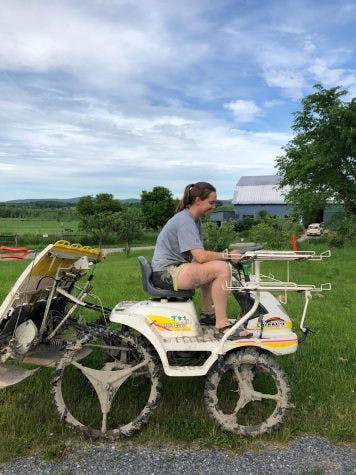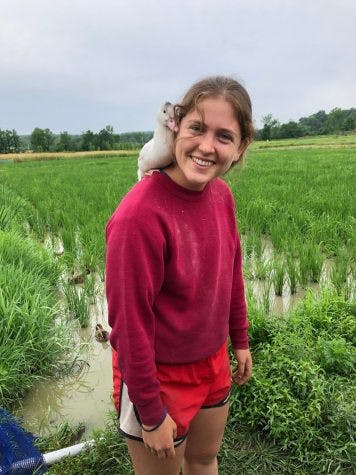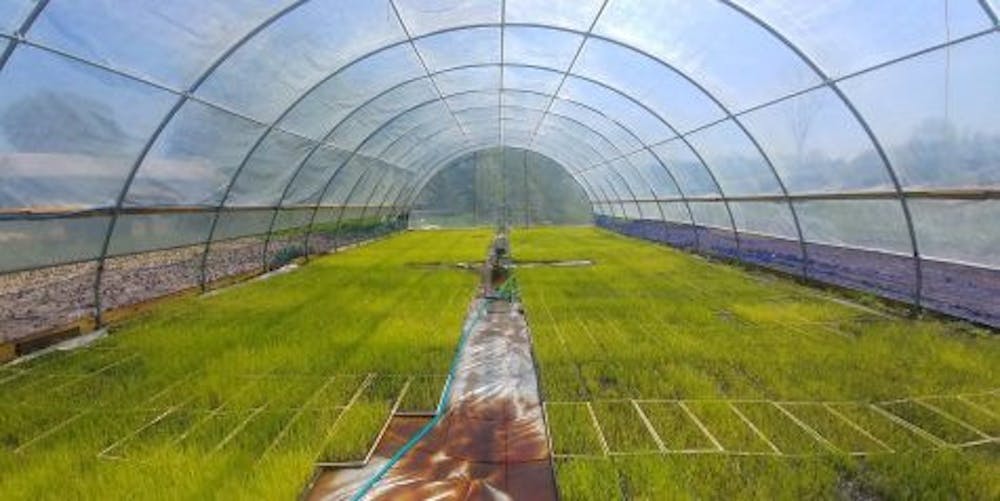Though corn and dairy are the staple crops for farmers in Addison County, Boundbrook Farm owner Erik Andrus decided to grow something different — rice. At his five-and-a-half-acre property, located 20 minutes north of Middlebury, Andrus maintains rice paddies on the largest rice farm north of the Mason-Dixon Line and east of the Mississippi River.
Boundbrook is not only distinctive for its crop choice, but also for its farming methodology. Andrus follows the traditions of “Aigamo,” or “duck-and-rice farming:” a Japanese farming practice where ducklings are released into rice paddies. Their activity clouds the water, destroying weed competition, as well as getting rid of snails and other bugs that could potentially harm the rice plants. Sticking to practice, owner Erik Andrus keeps 600 ducks on his farm each year, most of which are of the Khaki Campbell variety.

Katie Cox ’20.5 drove a specially imported Japanese rice-planting machine.
This past summer, Middlebury College students Lucy Kates ’20.5 and Katie Cox ’20.5 worked at Boundbrook Farm through the Middlebury FoodWorks internship. On their first day, they were told they needed to build two hutches to transport the ducks to and from the paddies.
“We kind of embarked on this small-scale construction project with [Andrus],” Cox said. “I didn’t have a bunch of construction experience, so it was my first time using staple guns, power saws and stuff like that. We made these two kinds of fortresses, and [Andrus] named both after French battleships.”
Other tasks included putting up fences around the fields to keep the ducks inside and transplanting rice seedlings in the paddies.
“We got to drive these Japanese-imported specialized rice planting machines,” Cox said. “They were unlike any machine I’ve ever seen.” Andrus taught Cox and Kates how to drive the equipment in one afternoon before sending them out to the paddies.
“It felt like we were definitely being entrusted with a very important task,” Kates said. “That was the foundation of the whole growing season.”
One week, Andrus attended a rice grower’s conference in Japan and left Cox and Kates to manage the farm. Among other responsibilities, the two were tasked with herding ducklings in and out of their hutches every day.
“That was often a pretty fun process,” Cox said. “It wasn’t super hard to coral them all, but sometimes we would have to chase the ducks down and grab the ones that were freaking out and trying to run away.”
Overall, the work environment on Boundbrook Farm is driven by Andrus’s commitment to flexibility and innovation.
“[Andrus] himself is still very much figuring out what ways work best for him and trying to navigate this import of a traditional method of agriculture, which has been practiced in Japan for thousands of years, into New England,” Kates said. “He was very open to different approaches, and it was very cool to feel like we could contribute new ideas.”
Andrus started out growing wheat in his early years in Addison County, but after struggling to dry the soil sufficiently, he switched to rice in 2010. He was inspired by the works of Takeshi and Linda Akaogi of Akaogi Farm in Putney, who had come to test Japanese rice varieties in Vermont. After attending their workshop at a Northeast Organic Farming Association conference, he committed himself to creating a commercial pilot operation for rice. Ten years later, he currently oversees six acres of the biggest rice installation in the Northeast.
Still, as a pioneer of this agricultural venture, he faces challenges.
“We just don’t have the extent of experience, knowledge or community resource for rice,” Andrus said. “When we encounter difficulties, we have to look to the other side of the world for peers that can help us. So that’s what makes the kind of farming we do also a cross-cultural communication project.”

A Khaki Campbell duckling perched on Lucy Kates ’20’s shoulder.
Andrus’ own life has been marked by cross-cultural experiences. He studied Arabic in Morocco from 1993 to 1994, has worked in construction, and for a while even lived in Japan as an English teacher. His biggest influence, however, was his study of Renaissance instrument making in Australia from a master lute maker named Bruce Tekle. Tekle was a handyman, gardener, adventurer, activist and a friend to Andrus.
“It was the growing things and living out in nature that stayed with me more than the lute making; just that envy of having a place around you that you could shape and create your own contract with away from the pressures of having a regular job,” Andrus said. “That was kind of the vision I held onto.”
Boundbrook Farm is currently preparing for harvest, which begins Oct. 7. But Andrus’ long-term enterprise is to expand ecological rice growing regionally, nationally and internationally.
“If the Northeast had been settled by Asians and not by Europeans, we would already have a lot of rice knowledge,” he said. “But because of the European mindset that we brought to this region, there’s a lot of opportunity for wetland growing that’s part of Asian tradition that has been totally underutilized and misunderstood by the current population.”
Andrus is looking to change that.
Rice paddies in Vermont? Vergennes farm boasts largest rice operation in Northeast

COURTESY PHOTO
Erik Andrus of Boundbrook Farm in Vergennes has been growing rice since 2010 on his five-and-a-half-acre property. The rice harvest begins October 7 this year.
Erik Andrus of Boundbrook Farm in Vergennes has been growing rice since 2010 on his five-and-a-half-acre property. The rice harvest begins October 7 this year.
COURTESY PHOTO
COURTESY PHOTO
Comments



